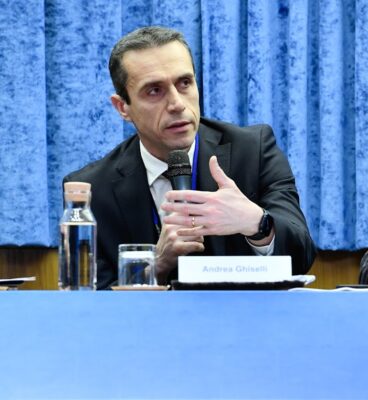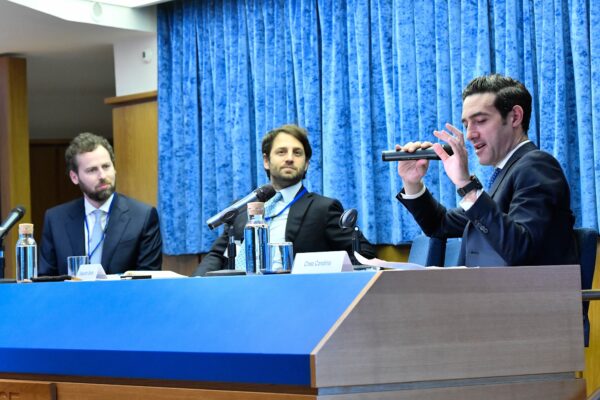
“We believe that human capital is the driving force that will provide the necessary impetus to achieve the set target. Technological innovation, attention to the territory, and market rules are the other essential elements of the path to integrating photovoltaics into the country’s electrical system.”
CHALLANGES AND OPPORTUNITIES FOR THE FULL INTEGRATION OF PHOTOVOLTAICS INTO THE ELECTRICAL SYSTEM – THE STORY OF OUR CONFERENCE
On February 21st, the annual EF Solare Italia conference “Photovoltaics: challenges and opportunities for the full integration into the electrical system” was held in Rome, at the prestigious headquarters of the GSE, organized in collaboration with the AEIT, moderated by Cheo Condina with the media partnership of Il Sole 24 Ore.
Over 150 people attended in person, with numerous others joining via streaming, witnessing a rich exchange among institutions, experts, and industry operators on the role of photovoltaics as a guiding source in the energy transition.
Renewables: a 700,000 job market
Opening the event was Paolo Arrigoni, President of the GSE, who explained how in just one year, approximately 370,000 new installations came into operation, adding 5 GW of new capacity, representing a growth of over 20% compared to 2022. Andrea Ghiselli, CEO of EF Solare Italia, reflected on the importance of creating a “photovoltaic generation” that constitutes the workforce capable of leading the country towards the goals of the 2030 Agenda.

“If we were to start training the specialized figures needed in this sector today, we would still be in time to cover the 700 thousand job positions in technical roles missing in solar and wind. We believe that human capital is the driving force that, if properly supported, will provide the necessary impetus to achieve the set target. Technological innovation, attention to the territory, and market rules are the other essential elements of the path to integrating photovoltaics into the country’s electrical system. To achieve the goals of the 2030 Agenda, these three areas must be developed in synergy by all sector operators with the support of institutions. We expect both the sector’s commitment to the development of new technological solutions capable of integrating into the territory and the continuation towards the definition of an enabling regulatory framework,” said Andrea Ghiselli, CEO of EF Solare Italia, emphasizing the importance of human capital.
Next, Luca Barberis, Director of the Renewable Sources Department at GSE, and Paolo Liberatore, Head of Statistics and Target Monitoring at the Markets, Sustainability, Studies Directorate of GSE, provided an overview of photovoltaics in Italy, revealing overwhelmingly positive data. In 2023, Italy reached a cumulative capacity of 30GW, generating a total of 30 TWh of gross production, of which approximately a quarter is self-consumed. Data from GSE also indicates that the growth observed in recent years concerns all sizes of photovoltaic installations. For installations larger than 1 MW and utility-scale, there was a recovery in the last quarter of 2023, but it is still the residential segment that is driving installations for the year. The leading regions for photovoltaics are Lombardy, Veneto, Piedmont, and Emilia-Romagna, while southern Italy, although growing, remains significantly behind except for Sicily, which ranks fifth in the list of regions with the highest capacity and production. There is also an increasing diffusion of storage systems associated with photovoltaic installations; in fact, by the end of 2023, there were approximately 536,000 in total (more than doubled compared to 2022), mainly concentrated in the residential sector.
Route to 2030

The conference continued with Tommaso Barbetti, Partner at Elemens, presenting the possible development scenarios of the Italian and European electrical systems by 2030, explaining that the connection requests are almost three times higher than the additional GW required by the PNIEC 2023, confirming the market’s interest in photovoltaics. The utility-scale installations currently in permitting would be sufficient to meet the 2030 target, a significant fact confirming the need to coordinate the authorization process to allow high-quality projects to access support mechanisms and be implemented within the required timeframe.
Alessandro Gentile, Partner at McKinsey, then addressed the role of human capital in the energy transition, a central theme that engaged both the audience present and those connected remotely. The research presented highlights the need to create about 700 thousand new technical job positions in solar and wind to achieve the goal of the 2030 Agenda, starting now to train individuals dedicated to the construction and maintenance of installations.
The role of institutions
The roundtable discussion followed, with the participation of Massimiliano Atelli (President of the VIA-VAS and PNRR-PNIEC Commission of the Ministry of the Environment and Energy Security), Fabio Bulgarelli (Director of Regulatory Affairs at Terna), Andrea Galliani (Director of the Energy Markets Directorate at ARERA), Andrea Ghiselli (CEO of EF Solare Italia), Alessandro Noce (Director-General of the Markets and Energy Infrastructure Directorate of the Ministry of the Environment and Energy Security), and Guido Stratta (President of the Kindness Academy, formerly Director of Personnel and Organization at the Enel Group).
From this panel emerged the need to reach a single text on renewable energies that harmonizes authorization procedures, a central issue to address to achieve the set objectives. Overall, the outlook remains positive: significant progress has been made on utility-scale photovoltaic installations, and many authorizations are being unlocked.
The growth of renewables is a concrete response to rising prices and to the pursuit of energy independence, with photovoltaics emerging increasingly as the driving force behind this process in our country. There is still work to be done to chart the course towards the electricity system of the future, but with the commitment of all stakeholders, it will be possible to reach the set targets.
Watch the video/photos here to relive the key moments of the conference.

